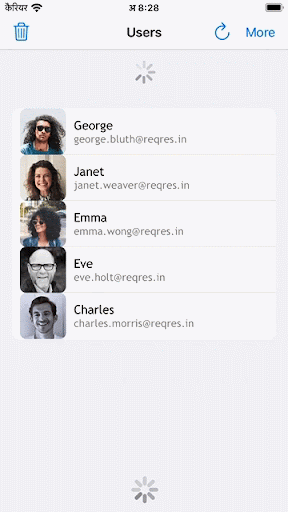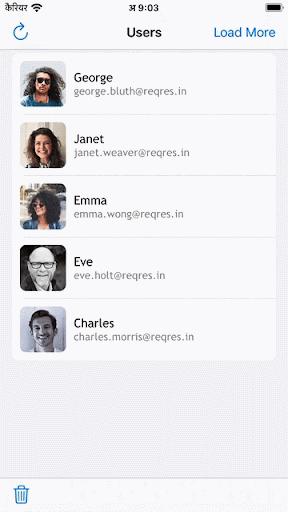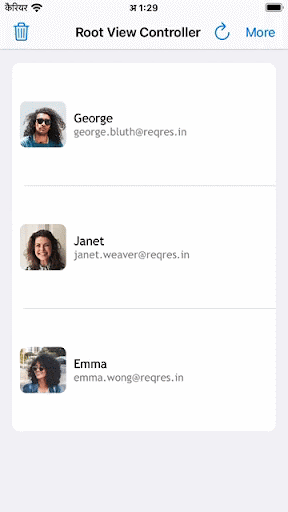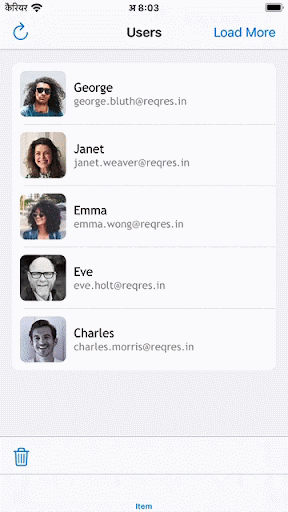IQPullToRefresh
Easy Pull to refresh and Load more handling on a UIScrollView subclass




IQPullToRefresh is a standalone library which can be plugged with UIScrollView subclasses like UITableView/UICollectionView to provide pull-to-refresh and load-more feature without any hassle. It also Provide customization mechanism using which you can create your own custom pull-to-refresh or custom load-more UI.
Requirements
| Library | Language | Minimum iOS Target | Minimum Xcode Version |
|---|---|---|---|
| IQPullToRefresh(1.0.0) | Swift | iOS 11.0 | Xcode 11 |
Swift versions support
5.0 and above
Installation
Installation with CocoaPods
IQPullToRefresh is available through CocoaPods. To install it, simply add the following line to your Podfile:
pod 'IQPullToRefresh'
Or you can choose the version you need based on the Swift support table from Requirements
pod 'IQPullToRefresh', '1.0.0'
Installation with Source Code
Drag and drop IQPullToRefresh directory from demo project to your project
Installation with Swift Package Manager
Swift Package Manager(SPM) is Apple's dependency manager tool. It is now supported in Xcode 11. So it can be used in all appleOS types of projects. It can be used alongside other tools like CocoaPods and Carthage as well.
To install IQPullToRefresh package into your packages, add a reference to IQPullToRefresh and a targeting release version in the dependencies section in Package.swift file:
import PackageDescription
let package = Package(
name: "YOUR_PROJECT_NAME",
products: [],
dependencies: [
.package(url: "https://github.com/hackiftekhar/IQPullToRefresh.git", from: "1.0.0")
]
)
To install IQPullToRefresh package via Xcode
- Go to File -> Swift Packages -> Add Package Dependency...
- Then search for https://github.com/hackiftekhar/IQPullToRefresh.git
- And choose the version you would like
Things you should understand before going into deep
RefreshType (Enumeration)
enum RefreshType {
case manual // When we manually trigger the refresh
case refreshControl // When the refreshControl trigger the refresh
}
LoadMoreType (Enumeration)
enum LoadMoreType {
case manual // When we manually trigger the load more
case reachAtEnd // When the moreLoader trigger the load more
}
Refreshable protocol (For Pull-To-Refresh feature)
It is used to get callback when refresh is triggered and also responsible to inform if loading has begin or loading has finished
func refreshTriggered(type: IQPullToRefresh.RefreshType,
loadingBegin: @Sendable @escaping @MainActor (_ success: Bool) -> Void,
loadingFinished: @Sendable @escaping @MainActor (_ success: Bool) -> Void)
MoreLoadable protocol (For Load-More feature)
It is used to get callback when load more is triggered and also responsible to inform if loading has begin or loading has finished
func loadMoreTriggered(type: IQPullToRefresh.LoadMoreType,
loadingBegin: @Sendable @escaping @MainActor (_ success: Bool) -> Void,
loadingFinished: @Sendable @escaping @MainActor (_ success: Bool) -> Void)
🤯 Current UsersViewController logic for load more 🥴 🤦
Approach 1
class UsersViewController: UITableViewController {
var users = [User](https://raw.github.com/hackiftekhar/IQPullToRefresh/master/)
private func getInitialUsers() { ... }
private func getMoreUsers() { ... }
private func refreshUI() { ... }
// Our Dirty 💩 logic to find load more condition, but this is not reliable to fulfil all edge cases
override func scrollViewDidScroll(_ scrollView: UIScrollView) {
if canLoadMore == true, loadMoreIndicatorView.isAnimating == false, (scrollView.isTracking == true || scrollView.isDecelerating == true) {
let bottomEdge = scrollView.contentOffset.y + scrollView.frame.height
let edgeToLoadMore = scrollView.contentSize.height - 100
if (bottomEdge >= edgeToLoadMore) {
getMoreUsers()
}
}
}
}
}
Approach 2
class UsersViewController: UITableViewController {
var users = [User](https://raw.github.com/hackiftekhar/IQPullToRefresh/master/)
private func getInitialUsers() { ... }
private func getMoreUsers() { ... }
private func refreshUI() { ... }
// Our Dirty 💩 logic to find load more condition, or some peoples also use another logic to load more when last cell visible, but this also have it’s own limitations like don’t have users control when user can decide to load more.
func tableView(_ tableView: UITableView, willDisplay cell: UITableViewCell, forRowAt indexPath: IndexPath) {
if canLoadMore == true,
loadMoreIndicatorView.isAnimating == false,
(indexPath.row + 1) == users.count {
getMoreUsers()
}
}
}
🤩 New UsersViewController (Pull To Refresh)
class UsersViewController: UITableViewController {
lazy var refresher = IQPullToRefresh(scrollView: tableView, refresher: self, moreLoader: self)
override func viewDidLoad() {
super.viewDidLoad()
refresher.enablePullToRefresh = true
refresher.enableLoadMore = false
}
}
extension UsersViewController: Refreshable {
func refreshTriggered(type: IQPullToRefresh.RefreshType,
loadingBegin: @Sendable @escaping @MainActor (_ success: Bool) -> Void,
loadingFinished: @Sendable @escaping @MainActor (_ success: Bool) -> Void) {
loadingBegin(true)
let pageSize = 10
APIClient.users(page: 1, perPage: pageSize, completion: { [weak self] result in
loadingFinished(true)
switch result {
case .success(let models):
self.models = models
let gotAllRecords = models.count.isMultiple(of:pageSize)
self.refresher.enableLoadMore = models.count != 0 && gotAllRecords
self.refreshUI()
case .failure:
break
}
})
}
}
🤩 New UsersViewController (Load More)
class UsersViewController: UITableViewController {
lazy var refresher = IQPullToRefresh(scrollView: tableView, refresher: self, moreLoader: self)
override func viewDidLoad() {
super.viewDidLoad()
refresher.enablePullToRefresh = true
refresher.enableLoadMore = false
}
}
extension UsersViewController: Refreshable, MoreLoadable {
func loadMoreTriggered(type: IQPullToRefresh.LoadMoreType,
loadingBegin: @Sendable @escaping @MainActor (_ success: Bool) -> Void,
loadingFinished: @Sendable @escaping @MainActor (_ success: Bool) -> Void) {
loadingBegin(true)
let pageSize = 10
let page = (models.count / pageSize) + 1
APIClient.users(page: page, perPage: pageSize, completion: { [weak self] result in
loadingFinished(true)
switch result {
case .success(let models):
self.models.append(contentsOf: models)
let gotAllRecords = models.count.isMultiple(of:pageSize)
self.refresher.enableLoadMore = models.count != 0 && gotAllRecords
self.refreshUI()
case .failure:
break
}
})
}
}
🥳
You have done adding pull-to-refresh and load more without any dirty 💩 & 🐞 buggy code

An abstract IQPullToRefresh wrapper class
Most of the time, the pull to refresh and load more erquirements are same like
- On pull to refresh, load 10 records using an api with page_index = 0 (or page_no = 1) and page_size = 10
- On load more, load next batch of 10 records using same api with page_index = 1 (or page_no = 2)and page_size = 10
- Keep current state of [Model] array which comes from servers. Example like on load more success then add new records at the end of array etc.
- Once server don’t have more records, disable load more feature.
IQRefreshAbstractWrapper abstract class blueprint
The IQRefreshAbstractWrapper mainly handles IQPullToRefresh delegate functions in most optimized way
open class IQRefreshAbstractWrapper<T> {
public let pullToRefresh: IQPullToRefresh
public var pageOffset: Int
public var pageSize: Int
public var models: [T]
public init(scrollView: UIScrollView,
pageOffset: Int, pageSize: Int)
public func addModelsUpdatedObserver(identifier: AnyHashable,
observer: (@Sendable @escaping @MainActor (_ result: Swift.Result<[T], Error>) -> Void))
public func addStateObserver(identifier: AnyHashable,
observer: (@Sendable @escaping @MainActor (_ result: RefreshingState) -> Void))
// Your subclass must override this function
open func request(page: Int, size: Int, completion: @Sendable @escaping @MainActor (Result<[T], Error>) -> Void)
}
How to use IQRefreshAbstractWrapper
Let’s assume, we would like to get list of many users (assume 100+), but 10 record each time when user pull to refresh or if user scroll then next 10 batch with load more. We'll need to create a subclass of IQRefreshAbstractWrapper class
UsersStore subclass
class UsersStore: IQRefreshAbstractWrapper<User> {
// Override the request function and return users based on page and size, that’s it.
open func request(page: Int, size: Int, completion: @Sendable @escaping @MainActor (Result<[T], Error>) -> Void) {
APIClient.users(page: page, perPage: size, completion: completion)
}
}
UsersViewController Implementation
You just need to create it's object and observe the modelsUpdatedObserver, when models list get's updated with either pull to refresh or load more, you'll get a callback here and you just need to connect those models with your UI now. It's this much simple to implement load more and pull to refresh now.
class UsersViewModelController: UITableViewController {
private lazy var usersStore: UsersStore = UsersStore(scrollView: tableView, pageOffset: 1, pageSize: 10)
override func viewDidLoad() {
super.viewDidLoad()
// usersStore.pullToRefresh.enablePullToRefresh = false // You can always customize most of the things here
usersStore.addModelsUpdatedObserver(identifier: "\(Self.self)") { result in
switch result {
case .success:
self.refreshUI(animated: true)
case .failure:
break
}
}
}
func refreshUI(animated: Bool = true) {
// Access usersStore.models to get list of users
}
}
Custom Pull To Refresh or Load more UI
This is all possible with implementing IQAnimatableRefresh protocol to your own UIView's subclasses.
IQAnimatableRefresh protocol Requirement
- The class who adopt it must be a UIView
- The class must implement 2 variables
var refreshLength: CGFloat { get } // Height of your refresh view. Width in case of horizontal scroll
var refreshState: IQAnimatableRefreshState { get set } //State handling
This can be
public enum IQAnimatableRefreshState: Equatable {
case unknown // Unknown state for initialization
case none // refreshControler is not active
case pulling(CGFloat) // Pulling the refreshControl
case eligible // Progress is completed but touch not released
case refreshing // Triggered refreshing
}
Protocol Adoption
class CustomPullToRefresh: UILabel, IQAnimatableRefresh {
var refreshLength: CGFloat {
return 80
}
var refreshState: IQAnimatableRefreshState = .none {
didSet {
guard refreshState != oldValue else { return }
switch refreshState {
case .none:
alpha = 0
text = ""
case .pulling(let progress):
alpha = progress
text = "Pull to refresh"
case .eligible:
alpha = 1
text = "Release to refresh"
case .refreshing:
alpha = 1
text = "Loading"
}
}
}
...
}
Assigning custom pull to refresh
class UsersViewController: UITableViewController {
...
override func viewDidLoad() {
super.viewDidLoad()
...
let customPullToRefresh = CustomPullToRefresh()
refresher.refreshControl = customPullToRefresh
...
}
...
}
Other useful functions
- public var enablePullToRefresh: Bool //Enable/Disable Pull To refresh
- var isRefreshing: Bool { get } //Return true if refreshing in progress
- func refresh() //Manually trigger refresh
- public var refreshControl: IQAnimatableRefresh //Custom refreshControl
- public var enableLoadMore: Bool //Enable/Disable load more feature
- var isMoreLoading: Bool { get } //Return true if load more in progress
- func loadMore() //Manually trigger load more
- public var loadMoreControl: IQAnimatableRefresh //Custom loadMore
LICENSE
Distributed under the MIT License.
Contributions
Any contribution is more than welcome! You can contribute through pull requests and issues on GitHub.
Author
If you wish to contact me, email me: [email protected]
GitHub
| link |
| Stars: 15 |
| Last commit: 14 weeks ago |
Swiftpack is being maintained by Petr Pavlik | @ptrpavlik | @swiftpackco | API | Analytics


